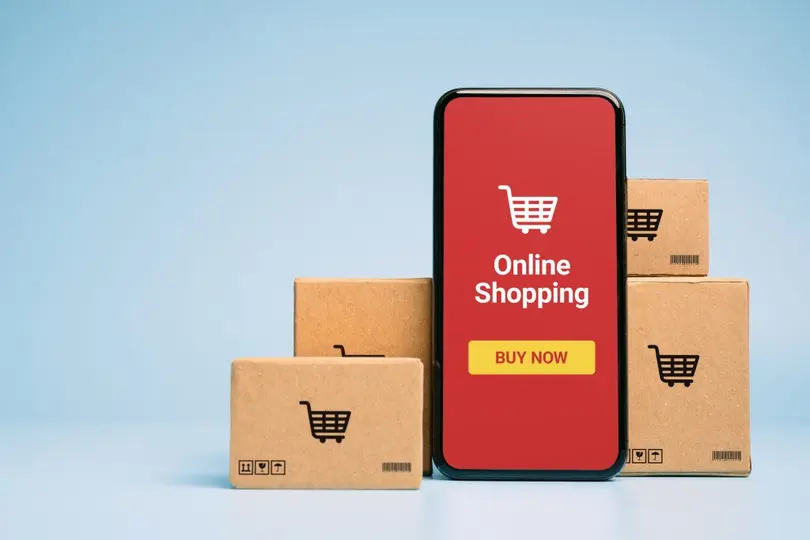eCommerce may have taken some time to threaten as a genuine alternative to bricks and mortar stores, but recent COVID related events have seen online businesses flourish like never before. Indeed, there are predictions that there will be more than 2 billion digital buyers globally during 2020. The value of global eCommerce retail sales rose from $1.34 trillion in 2014 to $2.84 trillion in 2018 and Is predicted to reach $4.88 trillion in 2021.
COVID lockdowns and the fear of infection when going to public places have led many people to shift their shopping online. And every indication is that this is a permanent shift in the general paradigm of retail commerce. People who previously had long developed habits of getting into their cars and driving to the nearest mall now pick up their phone, computer, or tablet and browse through an online catalog. Courier and freight companies are rushed off their feet with the increase in the volume of parcels to deliver, almost matching the decline in letters sent in recent years.
eCommerce 101: The Essentials of eCommerce:
What Counts as eCommerce?

Source: freepik.com
If you understand that eCommerce is simply a contraction of the term "electronic commerce," it becomes easy to understand just how massive the activity is. Technically, eCommerce encompasses all business activities carried out via the internet. If you buy or sell something online, then that is included in the eCommerce statistics.
Alright, it is at its most evident in online stores like Amazon. If you buy a copy of the latest blockbuster novel in the Amazon store, you have just engaged in eCommerce. However, there are many other eCommerce platforms and models that are less obvious. Do you pay your car licensing online? If so, that's eCommerce. Did you use an app to order a pizza and pay for it with your credit card? That's eCommerce, too. Are you a Fortnite fan who buys upgrades within the game? If so, you've participated in more eCommerce. Did you pay for and add security software to your laptop? That's still more eCommerce. The list of daily eCommerce transactions we make goes on and on.
Most firms that decide they want an eCommerce presence to create some form of eCommerce store or platform. This includes service businesses that take bookings and accept payments online. You certainly don't have to sell multiple products and be an Amazon clone for people to consider you to be involved in eCommerce.
Models of eCommerce
There are many different types of eCommerce business you can create.
However, we can look at eCommerce from at least three perspectives:
- By types of customer
- By the ways you make money
- By how you sell
If you set up an eCommerce business, it will likely fit in the model in each of these three perspectives. Of course, gigantic firms like Amazon position themselves in multiple categories to reach a massive audience.
If you group eCommerce businesses by type of customer, you could sell in the following ways:
- B2C – Business to Consumer, i.e., you predominantly sell to end-users
- B2B – Business to Business, i.e., you predominantly sell products/services / raw materials to other businesses
- B2G – Business to Government, i.e., you predominantly sell to government departments and agencies
However, there are a few eCommerce markets where the seller is the consumer, i.e.
- C2B – Consumer to Business, i.e., where people market their services to businesses, like with freelancing
- C2C – Consumer to Consumer, for example, when you sell items (as an ordinary person, not a business) to other people on a site like Craigslist, Facebook Marketplace, or eBay.
The most typical models for making money with eCommerce are:
- Selling your products to customers
- Selling "white label" products
- Wholesaling
- Dropshipping
- Selling by subscriptions
- Using a freemium model
The three most common ways that eCommerce businesses make their sales are:
- Marketing via social media
- On an online marketplace
- Via your own eCommerce store or business website
Most established eCommerce businesses operate their own eCommerce store but often use the other methods as additional marketing opportunities.
How Has eCommerce Changed Shopping?
Arguably the birth of eCommerce occurred as far back as 1969, with the establishment of CompuServe. This was obviously extremely primitive at first, relying on a dial-up connection. But it was here that some of the early features that later became essential to the internet first appeared. Over the next few decades, CompuServe introduced primitive forms of email and internet connectivity.
Michael Aldrich invented an early form of electronic shopping in 1979, using a modified TV and a transaction-processing computer connected by a telephone line.
The first eCommerce company, Boston Computer Exchange, was created in 1982 to facilitate people selling used computers.
Surprisingly, Amazon wasn't the first online bookseller – they didn't arrive until July 1994. Two years previously, Book Stacks Unlimited opened as an online bookstore on a dial-up bulletin board, although it didn't operate from Books.com on the internet until 1994.
Online eCommerce expanded relatively slowly over the late 1990s, and by 1999 the Chinese online marketplace, Alibaba launched. It is now a major online sales company, supplying predominantly bulk quantities of items to others wanting to sell retail amounts online.
A significant advance that made eCommerce simpler was the launch of Square in 2009. This made it easier for retailers to accept debit and credit cards anywhere.
As a result of the growth of eCommerce, traditional retailers have had to change their operating models. You will find few large bricks and mortar retailers who don't have a strong online presence now. The recent COVID crisis hastened this process, with people opting to shop online to keep away from in-store crowds.
One negative side effect is that traditional retailers are often shutting stores and making shop assistants redundant. Many well-known businesses have had to change their business models to survive. The combination of COVID and the increased popularity of eCommerce has led to massive change. Retailers, like Macy's, Nordstrom, and others, are facing a cash crunch like never before. Sure, much of this is due to the effects of Coronavirus lockdowns, but firms without a high-quality online sales platform have suffered considerably worse than their online competitors. Consumers are clearly favoring businesses engaging in online commerce and digital touchless methods, such as QR codes, contactless cards, and digital wallets, over traditional payment methods.
Why do People Use eCommerce?
One of the reasons consumers like eCommerce is that it lets them shop when they have the time and energy, rather than when a particular shop is open. It also widens their shopping options to purchase products not commonly available in their physical proximity. You can shop from millions of small businesses online, most of which you would never have heard of before eCommerce. Of course, if you are a small business owner, eCommerce greatly expands your pool of possible customers.
In earlier days, there was a reluctance to buy goods sight unseen. Indeed, there were many concerns about the safety of online payment systems. However, over time these have become less of an issue.
Many consumers were concerned about buying clothing online without first trying it for size. As a response, apparel retailers have found ways to describe their sizing better, making it safer for people to risk making a purchase. Whereas once you might have had to go to a specialist shoe store to buy your Size 10 trainers, you now can determine that you actually need a Size 10 Wide, and buy a pair with the confidence that you will fit them when their parcel arrives at your door.
Technology has also changed the way we use digital products in recent years. In the past, you might have gone down to a "record shop" to pick up an LP, cassette, or compact disc with your preferred music. Now you simply use an app like Spotify, paying a subscription for Spotify Premium if you don't want ads and stream the tracks that interest you. You can still buy physical books from Amazon, but many people now purchase eBooks and download a copy of what they are reading to their devices. In previous times you might have gone to a computer (or office supplies) store and bought a copy of Microsoft Office, installing it onto your computer from many disks. Nowadays, you're much more likely to pay a monthly subscription for Office 365, and either download it to your laptop or use the web version, with no need to download software at all.
A natural evolution of eCommerce was the opening of easy-access online marketplaces. You can easily sell unwanted items online now, rather than using old-style classified ads in the newspaper. This has again expanded the range of people who will see what you have available.
Downsides to eCommerce
The most obvious disadvantage of eCommerce for firms that haven't changed their operating models quickly enough is the enforced closure of existing stores with the accompanying redundancy of many retail workers. Some of these people may have moved into another function for online businesses, working in an online warehouse, for instance, but there will be clear losers here.
Retailers and other online sellers are now more distant from their customers than previously. You don't have the opportunities to talk to your customer daily like you can in a store. This means that you need to find other ways to gather data, for example, surveying your existing customers.
You are also very reliant on technology throughout the entire process. Every time something breaks down, your store can come to a rapid halt. This can be caused by something beyond your control, like your web host going offline for a few crucial hours, or a payment processor having security issues.
And as much as online retailers have improved the way you can view products and found better descriptions for things like sizing, consumers still can't easily pick up, feel and try out potential online purchases.
Steps to Setting up an eCommerce Business
While we won't go through how to set up an eCommerce business in detail here, we have covered some of the essential factors in our Introductory Guide to eCommerce.
The key questions you need to ask yourself as part of your planning are:
- What types of products do you intend to sell?
- How will you source products?
- To whom do you intend to sell?
- How do you plan to sell your goods?
- How will you build your eCommerce store or other sales method?
- How much money will you need up-front?
Once you can answer these questions, you can go about building your eCommerce business. The main steps to go through when setting up your eCommerce business are:
- Choose your business model and products
- Choose your platform
- Build your eCommerce website
- Choose your payment solution
- Optimize your site for conversion
Frequently Asked Questions
What is eCommerce?
In short, eCommerce is simply a contraction of the term “electronic commerce”. Technically, the term includes all business activities that are completed by means of the Internet. So, when someone buys or sells something online, it will be regarded as eCommerce. The majority of established eCommerce businesses operate their own eCommerce store, but in many instances also use other methods as extra marketing opportunities.
Why is eCommerce so popular?
One of the reasons why ecommerce is so popular among consumers is that eCommerce enables them to shop when it is convenient for them, or, put more simply, when they have the time and energy. It also increases their shopping options. Thanks to eCommerce, consumers can now purchase products that are not commonly available in their area. This also applies to small business owners as eCommerce widens their pool of possible customers significantly.
What are the cons of eCommerce?
One of the most obvious cons is that businesses that have not changed their operating model quickly enough could be forced to close their existing brick-and-mortar stores. This also means that many retail workers can lose their jobs. Another disadvantage to eCommerce is that retailers and customers are more distant from one another. Not only does this mean that there are fewer opportunities for conversation, but consumers are also missing out on the ability to pick up and feel potential purchases beforehand.
How can you make money with eCommerce?
There are various models that you can use to make money by means of eCommerce. Some of the most popular models include selling “white label” products, wholesaling, dropshipping, selling by subscriptions or using a freemium model. There are also various ways that you can make your sales. The most common ways that eCommerce businesses make their sales are by means of their own eCommerce store, using an online marketplace or marketing by means of social media.
How do you start an eCommerce business?
To set up an eCommerce business, here are the main steps that you need to complete:
1. Select your business model and products
2. Select your platform
3. Create your eCommerce website
4. Choose your payment solution
5. Optimize your site for conversion





